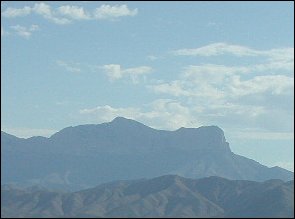

The Guadalupe Mountains rise majestically out of the surrounding land, with El Capitan, the southernmost peak, a landmark known throughout the northern Chihuahuan Desert. Laid down in the Permian Period some 250 million years ago, Capitan Reef is a huge fossilized marine reef complex that forms much of the mountain chain's bulk.
This horseshoe-shaped structure consisted of a reef some 400 miles long, growing in a shallow sea near the western edge of Pangaea, a land mass encompassing virtually all dry land on earth. Lime-secreting organisms such as calcareous sponges and algae, aided by vast quantities of lime precipitated directly from the waters of the shallow sea, built this massive edifice. Later buried by vast quantities of minerals deposited by the drying body of water, the reef has been preserved much as in life.
Uncovered by erosion millions of years later, the reef complex today is
a feast for the eyes above the ground with its towering mountain face and below ground,
where the famous Carlsbad Caverns lie embedded deep within the reef.

Contributor: Arthur H. Harris, Laboratory for Environmental Biology, Centennial Museum, University of Texas at El Paso.
Desert Diary is a joint production of the Centennial Museum and KTEP National Public Radio at the University of Texas at El Paso.

The Guadalupe Mountains as seen from the west. The high peak on the right is El Capitan. Photograph by A.H. Harris